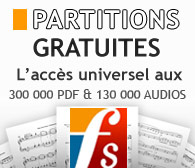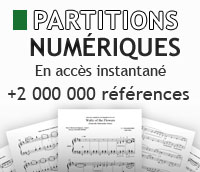 Non classifié 210 892
Non classifié 210 892
Piano & claviersPiano seul 270 614Piano, Voix et Guitare 154 839Piano, Voix 113 915Piano Facile 70 435Orgue 16 261Instruments en Do 14 275Piano grosses notes 10 0231 Piano, 4 mains 7 954Accordéon 6 451Accompagnement Piano 6 356Piano Trio: piano, violon, violoncelle 2 231Piano (partie séparée) 1 7242 Pianos, 4 mains 1 476Ligne De Mélodie, Piano 564Piano Quatuor: piano, violon, alto, violoncelle 561Piano Quintette: piano, 2 violons, alto, violoncelle 542Piano Quatuor: piano, 2 violons, violoncelle 476Orgue, Trompette (duo) 429Orgue, Piano (duo) 382Clavecin 292Clavier 2661 Piano, 6 mains 240Accordéon, Voix 217Instrument seul et Orgue 1652 Pianos, 8 mains 942 Accordéons 78Ensemble d'Accordéons 56Orgue, Voix 472 Orgues (duo) 30Tous Les Instruments 23Fake Book 16Accordéon, Piano 13Accordéon, Corde(s) 12Accordéon et Orchestre 8Piano Quintette: piano, violon, alto, violoncelle, contre basse 6Ensemble de Pianos 6Orgue et Orchestre 5Concertina 33 Pianos 2Piano Trio: Instruments de chambre mixtes 2
GuitaresGuitare notes et tablatures 79 494Ligne De Mélodie, (Paroles) et Accords 50 514Guitare 29 947Paroles et Accords 24 260Ukulele 18 834Basse electrique 13 3432 Guitares (duo) 2 261Guitare (partie séparée) 2 141Banjo 1 567Mandoline 1 3434 Guitares (Quatuor) 1 058Dulcimer 931Piano, Guitare (duo) 908Ensemble de guitares 7133 Guitares (trio) 524Basse électrique (partie séparée) 415Ukulele Baryton 326Partitions De Groupes 280Guitare Pedal Steel 210Ensemble de Ukulélés 207Dobro 922 Dulcimers (duo) 83Mandoline, Piano (duo) 79Mandoline, Guitare (duo) 65Guitare Tab, Voix, Basse, Batterie 40Guitare, Violon, Violoncelle (trio) 402 Ukuleles 313 Dulcimers (trio) 21Guitare, Flûte, Clarinette 18Orchestre à Plectres 16Guitare, Orchestre 122 Mandolines (duo) 11Guitare, Quatuor à cordes 11Cithare 8Luth 7Bouzouki 52 Guitares et Orchestre 42 Guitares et Piano 2Guitare, Harpe 22 Guitares, Clarinette (trio) 1
VoixChorale SATB 68 098Chorale 3 parties 27 449Pack Instrumental pour Chorale 19 899Chorale 2 parties 15 987Chorale TTBB 13 375Voix seule 9 130Chorale 8 739Chorale SSAA 6 988Chorale Unison 6 279Voix duo, Piano 3 663Voix haute 2 146Voix duo 1 547Voix Soprano, Piano 1 467Voix Tenor, Piano 848Voix basse, Piano 799Voix Alto, Piano 796Voix Baryton, Piano 596Voix, Guitare 407Voix moyenne, Piano 395Chorale SSATB 332Voix Moyenne 247Chorale SSAATTBB 238Voix Mezzo-Soprano, Piano 195Chorale SSATTB 160Voix Tenor 141Chorale SSATBB 125Soli, choeur mixte et accompagnement 106Chorale SATTB 93Chorale SSAB a cappella 83Voix Soprano 82Voix haute, Piano 63Chorale SSAB, Piano 62Chorale, Orgue 59Voix et basse continue 55Chorale SSAATB 53Voix basse 51Voix d'Enfants 43Chorale SAATB A Cappella 32Chorale SATBB 25Male Voice 25Voix Baryton 19Chorale, Orchestre 13Chorale SATTBB, Clavier 11Chorale SSAATB A Cappella 10Voix duo, Orgue 10Voix Soprano, Orchestre 9Chorale SATTBB A Cappella 6Voix (avec Boîtes d'Accords) 4Paroles Seulement 3Voix d'Enfants, Piano 2
VentsSaxophone (partie séparée) 26 513Flûte traversière 22 680Clarinette 20 320Saxophone 18 238Clarinette (partie séparée) 14 985Flûte traversière et Piano 14 253Saxophone Alto 13 052Saxophone Tenor 11 413Quatuor de Saxophones: 4 saxophones 11 324Clarinette et Piano 10 299Saxophone Alto et Piano 7 845Hautbois, Piano (duo) 7 6142 Saxophones (duo) 7 493Quintette à Vent: flûte, Hautbois, basson, clarinette, Cor 7 395Flute (partie séparée) 7 113Flûte, Hautbois, Clarinette, Basson 6 6202 Flûtes traversières (duo) 6 416Hautbois (partie séparée) 6 341Quatuor de Clarinettes: 4 clarinettes 5 957Saxophone Tenor et Piano 5 6572 Clarinettes (duo) 5 452Quatuor de Flûtes : 4 flûtes 3 451Saxophone Soprano et Piano 3 360Quintette de Saxophone: 5 saxophones 2 906Hautbois 2 6613 Saxophones (trio) 2 563Flûte à Bec 2 4563 Clarinettes (trio) 2 456Flûte, Clarinette (duo) 2 070Flûte et Guitare 2 065Ensemble de Clarinettes 1 933Trio de Flûtes: 3 flûtes 1 925Instruments en Mib 1 858Ensemble de Flûtes 1 578Saxophone Baryton, Piano 1 513Quintette de Clarinettes: 5 clarinettes 1 413Saxophone Soprano 1 412Ensemble de saxophones 1 3952 Hautbois (duo) 1 2922 Flûte à bec (duo) 1 269Cor anglais, Piano 1 173Hautbois, Basson (duo) 1 067Harmonica 1 055Quatuor de Flûtes à bec 997Flûte, Violon 913Ocarina 902Clarinette, Violon (duo) 855Flûte à bec Soprano 811Hautbois, Clarinette (duo) 804Clarinette Basse, Piano 730Flûte, Clarinette et Basson 712Flûte, Hautbois, Clarinette (trio) 695Saxophone, Clarinette (duo) 674Flûte, Violon, Piano 656Clarinette, Basson (duo) 582Flûte, Violoncelle 555Flûte à bec Alto 542Flûte, Hautbois, Basson 5353 Flûtes à bec (trio) 513Clarinette, Guitare (duo) 511Flûte, Hautbois (duo) 508Hautbois, Clarinette, Basson (trio d'anches) 505Quintette de Flûte : 5 flûtes 432Piccolo 426Clarinette Basse 410Saxophone Baryton 401Hautbois, Flûte 392Cor Anglais 373Clarinette, Violoncelle (duo) 371Flûte à bec Soprano, Piano 371Flûte, Clarinette, Piano (trio) 364Clarinette, Trompette (duo) 351Flûte à bec Alto, Piano 348Flûte, Trompette (duo) 339Flûte, Alto (duo) 333Piccolo, Piano 330Flûte, Violoncelle, Piano (trio) 315Flûte, Violon et Violoncelle 313Clarinette et Alto 3065 Flûtes à bec 281Flûte à Bec, Piano 2762 Saxophones, Piano 274Flûte à bec Tenor 272Flûte, Saxophone (duo) 2712 Flûtes traversières, Piano 268Clarinette, Harpe (duo) 263Ensemble De Flûte à bec 256Hautbois, Violoncelle 245Saxophone et Guitare 2433 Hautbois 235Hautbois, violon (duo) 219Saxophone et Piano 2092 Clarinettes, Piano 206Flûte, Trombone (duo) 181Flûte, Basson et Piano 175Hautbois, Guitare (duo) 135Clarinette, Violoncelle, Piano (trio) 132Flûte, Hautbois, Piano (trio) 130Flûte, Hautbois, Violon 124Flûte irlandaise 121Clarinette, Trombone (duo) 119Flûte, Clarinette, Violon (trio) 113Saxophone, Violon (duo) 110Cor anglais, Guitare (duo) 103Hautbois, Trompette (duo) 1022 Clarinettes, Basson 101Ensemble à vent 100Cornemuse 934 Hautbois 87Flûte à bec, Guitare (duo) 85Flûte, Alto et Piano 81Flûte, Harpe et Violoncelle 79Flute, harpe et violon 78Flûte traversière, Orgue (duo) 77Hautbois et alto (duo) 77Clarinette, Basson, Piano (trio) 76Flûte, Clarinette, Cor, Basson (Quartet) 73Flûte et Trio à cordes 68Saxophone et Orgue 63Flûte, Violon, Violoncelle et Piano 63Quatuor de Clarinettes: Clarinette, Violon, Alto, Violoncelle 63Flûte à bec Alto, Basse continue 55Saxophone, Basson (duo) 49Hautbois, trombone (duo) 48Hautbois, Harpe 46Flûte et Quatuor à Cordes 45Clarinette, Alto et Piano (trio) 45Harmonica, Piano 45Flûte, Tuba (duo) 45Saxophone et Harpe 44Quintette de Clarinette: Clarinette, Quatuor à Cordes 39Flûte traversière, Basse continue 38Flûte, alto et harpe 372 Cors Anglais Et Pianoforte 36Saxophone et violoncelle 34Flûte, trombone et piano 33Hautbois, Basson et Piano 32Flûte traversière, Orchestre 31Flûte, Violoncelle, Guitare 31Clarinette, Tuba 30Flûte, Violon, Guitare 29Hautbois, Violoncelle et Piano 282 Flûtes à bec, Piano 28Hautbois, Violin, Alto et Violoncelle (Quatuor) 27Flute, Cor (duo) 25Clarinette, trompette et piano 25Clarinette, Orgue 25Clarinette, Orchestre 242 Hautbois, Piano 22Flûte, Alto et Violoncelle 19Hautbois, Violon, Piano 19Clarinette, Contrebasse (duo) 16Hautbois, Clarinette et Piano (Trio) 16Cor anglais et Harpe (duo) 15Saxophone et Orchestre 15Ensemble de Hautbois 142 Flûtes traversières, Guitare 142 Harmonicas 11Flûte à bec Soprano, Basse continue 11Hautbois, Orgue 102 Hautbois et Cor anglais 10Flûte à bec, Harpe 102 Flûtes traversières, Harpe 10Saxophone, Tuba (duo) 9Clarinette, Quatuor à cordes et Piano 92 Hautbois et Basson 9Flûte de Pan 82 Flûtes, 2 Clarinettes (Quatuor) 7Hautbois et Orchestre 7Flûte, Guitare, Piano 72 Flûtes, Basse continue 6Melodica 5Hautbois, Quatuor à cordes 4Clarinette, Saxophone, Piano 3Hautbois, Clarinette, Basson et Piano 32 Flûtes à bec, Guitare 23 Flûtes à bec, Piano 22 clarinettes, 2 bassons 2Flute, alto, violoncelle et guitare 12 Hautbois, 2 Cors et 2 Bassons 1
CuivresTrompette 18 717Trombone (partie séparée) 18 496Trompette (partie séparée) 18 010Trombone 15 513Quintette de Cuivres: 2 trompettes, Cor, trombone, tuba 10 430Cor 8 796Trompette, Piano 7 331Cor (partie séparée) 6 820Trombone et Piano 6 118Tuba (partie séparée) 4 974Quatuor de Cuivres : 2 trompettes, trombone, tuba 4 492Cor et Piano 4 4782 Trompettes (duo) 3 197Tuba 3 1602 Trombones (duo) 2 742Quatuor de Cuivres 2 255Tuba et Piano 2 159Quatuor de Cuivres: 2 trompettes, Cor, trombone 1 862Bass Clef Instruments 1 823Instruments en Sib 1 797Quatuor de cuivres: 4 trombones 1 472Trompette, Trombone (duo) 1 458Euphonium, Piano (duo) 1 306Euphonium 1 2682 Cors (duo) 1 204Cor anglais, Piano 1 173Quatuor de cuivres: 4 cors 1 0442 Euphoniums et 2 Tubas 1 036Trio de Cuivres 7184 Tubas 654Trompette, Saxophone (duo) 651Trompette, Cor (duo) 566Ensemble de Trombones 5023 Trombones (trio) 4903 Trompettes (trio) 402Tuba ou Euphonium ou Saxhorn 381Cor Anglais 373Cornet A Pistons 3682 Tubas (duo) 366Quatuor de cuivres: 4 trompettes 310Instruments en Fa 303Ensemble de Cors 282Trombone basse et Piano 281Ensemble de Trompettes 272Trompette, Tuba (duo) 245Trombone, Tuba (duo) 231Tuba et Orgue 1572 Trompettes, Clavier (piano ou orgue) 153Euphonium, Tuba (duo) 147Trombone, violoncelle (duo) 140Trompette, violon (duo) 135Trombone, Cor (duo) 126Trombone basse 123Trompette, Basson (duo) 119Cor, Violoncelle (duo) 118Cor, Tuba (duo) 117Quatuor de cuivres: 2 trompettes, 2 trombones 1143 Cors (trio) 108Cor anglais, Guitare (duo) 103Trombone, Violon (duo) 93Trompette, Violoncelle (duo) 88Ensemble de Tubas 84Euphonium (partie séparée) 832 Euphoniums (duo) 81Trombone, Orgue 62Cor et Harpe 56Trompette, Trombone, Piano 50Cor et Basson (duo) 49Trompette, Violoncelle et Piano 45Quatuor de cuivres: Cor, Trombone, Tuba, Trompette Sib 432 Trombones, Piano 42Trompette, Harpe 39Trompette et Guitare 372 Cors Anglais Et Pianoforte 36Clarinette, Cor (duo) 353 Tubas (trio) 31Trombone, Alto (duo) 28Cor et Orgue 224 Euphoniums 20Cor, Trompette, Trombone (trio) 20Trompette, Orchestre 192 Cors, Piano 18Bugle 18Cornet et Piano 173 Euphoniums 15Cor anglais et Harpe (duo) 15Quintette de Cuivres: 2 trompettes, Cor, 2 trombones 14Cor, Orchestre 10Trompette, Euphonium (duo) 8Trombone et orchestre 8Cor, Violoncelle et Piano 7Euphonium Ou Saxhorn Et Piano 5G Instruments 4Saxhorn basse ou Euphonium ou Tuba et Piano 3Cornet et orchestre 2
CordesQuatuor à cordes: 2 violons, alto, violoncelle 33 581Violon 23 514Violon et Piano 19 176Violoncelle 15 590Alto seul 12 971Violoncelle, Piano 12 133Violon (partie séparée) 10 216Harpe 9 019Alto, Piano 8 9302 Violons (duo) 6 170Violon, Violoncelle (duo) 5 850Contrebasse (partie séparée) 5 089Trio à Cordes: violon, alto, violoncelle 4 6532 Violoncelles (duo) 4 353Alto (partie séparée) 3 466Violoncelle (partie séparée) 3 294Violon, Alto (duo) 2 692Contre Basse 2 4202 Altos (duo) 2 124Quintette à cordes: 2 violons, alto, violoncelle, basse 2 117Contrebasse, Piano (duo) 1 790Trio à Cordes: 2 violons, violoncelle 1 780Alto, Violoncelle (duo) 1 4274 Violoncelles 1 123Trio à cordes: 3 violins 1 014Violon, Guitare (duo) 911Trio à cordes 880Piano Trio: Violon, Alto, Piano 817Harpe, Flûte (duo) 726Trio à Cordes: 3 violoncelles 710Violoncelle , Guitare (duo) 6812 Harpes (duo) 639Quatuor à cordes: 4 violons 530Harpe, Violon (duo) 411Trio à Cordes: 2 violons, alto 367Alto, Guitare (duo) 362Trio à cordes: 3 altos 3572 Contrebasses (duo) 3542 Violons, Piano 347Quatuor à cordes : 4 altos 346Violoncelle, Contrebasse (duo) 326Violon, Basson (duo) 257Alto et Basson 167Quintette à cordes: 2 violons, 2 altos, violoncelle 163Harpe, Violoncelle (duo) 1282 Violoncelles, Piano 119Harpe et Piano 107Violon, Clarinette, Piano (trio) 105Harpe, Voix 96Quintette à cordes : 2 violons, alto et 2 violoncelles 95Ensemble de Violoncelles 93Harpe (partie séparée) 90Violon, Orgue 81Violoncelle, Orgue 752 Altos, Piano 72Alto et Harpe 72Violoncelle, Orchestre 684 Contrebasses 66Flûte, Contrebasse (duo) 60Violon, Basse continue 55Harpe, Violon, Violoncelle 48Ensemble de Violons 483 Contrebasses 43Violoncelle, Basse continue 412 Violons et Basse continue 393 Harpes 34Violon, Tuba (duo) 32Ensemble d'Altos 31Harpe et mandoline 24Autoharp 21Alto et orchestre 19Violon, Contrebasse (duo) 16Violon, Violoncelle, Clarinette 16Alto, Orgue 16Violoncelle et Marimba 15Harpe, Trombone (duo) 15Violon, Trompette et Piano 144 Harpes 12Harpe, Orchestre 9Harpe et Orgue 85 Harpes 6Harpe, Quatuor à cordes 6Ensemble de Contre basses 3Violon, Clarinette et Guitare 3
Orchestre & PercussionsOrchestre d'harmonie 77 069Orchestre 20 984Orchestre à Cordes 19 328Fanfare 17 443Ensemble Jazz 16 961Batterie 12 806Percussion (partie séparée) 9 158Cloches 6 577Ensemble de cuivres 5 670Orchestre de chambre 3 612Percussion 3 170Batterie (partie séparée) 2 658Jazz combo 2 528Timbales (partie séparée) 2 283Ensemble de Percussions 1 557Marimba 708Timbales 544Xylophone 524Vibraphone 454Quintette à Vent 310Instrumentation Flexible 282Caisse Claire 189Xylophone, Piano 156Piano et Orchestre 144Quatuor à Vent : 4 instruments à vents 120Vibraphone (partie séparée) 96Orchestre, Violon 71Big band 692 Xylophones 63Quintette à cordes : 2 Violons, Alto, Violoncelle, Contrebasse, Clavier 61Quintette de Cuivres: autres combinaisons 41Xylophone (partie séparée) 35Vibraphone et Marimba 33Batterie-Fanfare 32Vibraphone, Piano 29Orchestre Symphonique 27Ensemble d'École 252 Marimbas 24Trio à Vent: 3 instruments à vents 183 Marimbas 18Marimba, Piano (duo) 17Marimba et Orgue 13Xylophone ou Marimba ou Vibraphone 12Voix et Orchestre 113 Percussions 112 Percussions 8Bongos 72 Caisses Claires (duo) 6Conga 4Cajon 4Mariachi 4Marimba ou Xylophone et Piano 3Bodhran 34 Percussions 2Voix Mezzo-Soprano, Orchestre 2Marimba, Saxophone (duo) 1Caisse Claire, Piano 1
|

|





